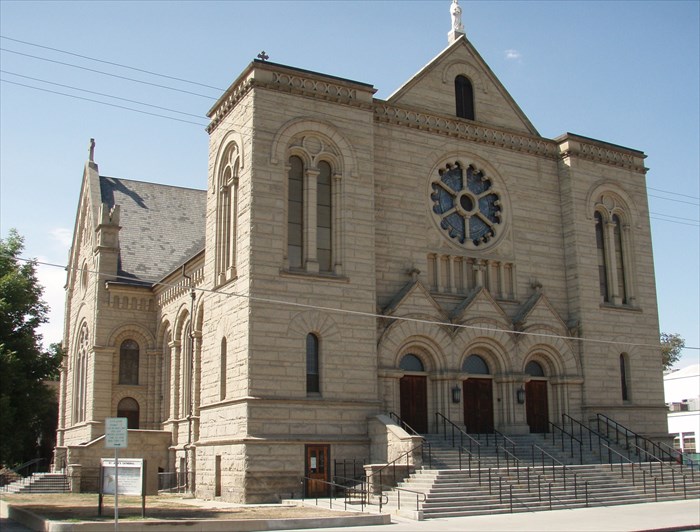
The official church web site offers these glimpses into the history and architecture of this landmark building which is listed with the National Register of Historic Places.
"The Cathedral of St John the Evangelist was begun in 1906 by Bishop Alphonse Glorieux. Father Glorieux was the newly appointed Bishop of the Vicar Apostolic of Idaho when he arrived in Boise from St Michael's College in Portland, Oregon, in 1883. Under his leadership, the Vicariate had grown from two priests and 1500 parishioners to a population of 7000 Catholics, 27 churches, and 10 secular priests by 1893. Four schools, an academy, and two hospitals had also been created. Due to this growth of the Catholic community as well as Idaho assuming statehood, the Vicariate became the Diocese of Boise in 1893 with Bishop Glorieux at its head.
Bishop Glorieux soon recognized the need for a larger structure than the original frame cathedral at the NW corner of the 9th and Bannock Streets. Thus, the square block surrounded by Fort, Hays, 8th and 9th Streets was purchased and the cornerstone laid in 1906. Not wanting to see the parish go into debt erecting the new cathedral, the Bishop saw to it that it was built in stages. By 1912 the walls and roof were completed and church services were held in the basement. The upstairs church -- the Cathedral as we know it today -- was completed by Bishop Gorman and was dedicated on Easter Sunday 1921.
St John's was designed by the early-Boise architectural firm of Tourtellotte & Hummel in the Romanesque style, particularly using the German cathedral of Mainz as a model and is the largest church of its type in Idaho. It is built in a cruciform plan, or the building is shaped like a cross, and measures 170 feet from front rear, 95 feet across the transcepts and 65 feet across the nave. The exterior walls are Boise Sandstone from the Tablerock quarry east of the city.
The main entry facade has two corner towers and a large rose window of stained glass. The towers and the nave have large round-arched windows. The corner towers were designed to have tall spires similar to the spire seen at the roof crossing of the nave and transepts, but the front towers were never completed. The transcept windows have three sections contained in a larger arched opening. A continuous band of small projecting arches called "corbels" crosses the facade and extends around the cathedral at the junction of the walls and roof uniting the entire building. A center gable rises above the main entry with a statue of St John the Evangelist adorning the peak."
The
Boise Architecture Project offers these additional details about the design of The Cathedral of St. John the Evangelist:
"St. John's Cathedral on 8th Street was finished in 1921. The first Catholic Church in the area was St. Joseph's in Idaho City which burned down in 1867. St. Joseph's School which is next to St. John's is named in memory for this church. Then, in 1870, Boise's first Catholic Church, St. Patrick's, located on the same block as the old St. Al's Hospital was, was finished. Unfortunately, the structure burnt down seven days after it was finished!
The Diocese of Boise originally built St. John's where the downtown Yen Ching restaurant is now located. The parish quickly outgrew this location and Bishop Alphonse Glorieux decided to buy the current location on 9th and Hays St. Originally, there was an attempt to move the old church to its new location but along the way, the building brushed a electric line and caught fire, partially burning. So Bishop Glorieux approached the architectural firm Tourtellette and Hummel to design it. Mr. Tourtellette originally proposed a Gothic design and Mr. Hummel suggested a Romanesque design. The Romanesque design was chosen and the corner stone was laid in 1906.
Bishop Gorman decreed that the parish would not go into debt in building the new cathedral and therefore progress was slow. Construction was suspended during World War I and then resumed in 1919. The Cathedral was constructed out of Boise sandstone even though supposedly the original plans were to use brick. But, as the story goes, the Baptist church was being constructed at the same time out of brick and so sandstone was chosen to match the beauty of St. Michael's. The parish was not to be outdone by the Episcopalians! St. John's was finished with the roof and towers complete on Easter in 1921 after an incredible amount of work was completed in the last two years.
Finishing it that quickly was said to be its own "miracle" despite the fact that due to cost cutting, the originally designed pointed towers were truncated to be flat. The interior of the cathedral highlights the Romanesque design. Features include 3 feet thick walls to support the heavy slate roof, round wide arches, slanted windowsills, and bright colored painting. The many beautiful stained glass windows are mostly colored glass with only the faces of the figures painted on. The windows were designed and installed mostly by the John Kinsella Glass Company of Chicago, but the Holy Spirit window was done by the Rambusch Decorating Company of New York."